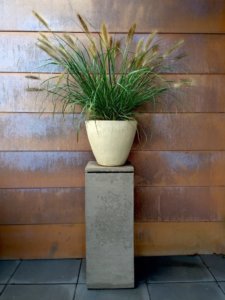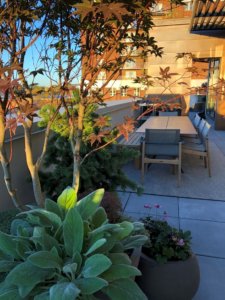Dreamy Rooftop Garden in 3 Steps with a Planterra Pro
Rooftop gardens are steadily gaining popularity as city dwellers seek out ways to reconnect with nature. Planterra Plantscapes Creative Director Sarah Stalker considers them some of her favorite spaces to design.

Green rooftops provide a sanctuary in an urban environment.
“Rooftops are often untapped opportunities to create peaceful retreats, exciting entertainment spaces and vantages for awesome city views,” she says.
Planterra offers a three-step process to transform a rooftop into an urban oasis:
- Make a rooftop site visit
This is an opportunity to discuss a client’s ideas, goals for the space, and style inspirations – as well as how involved they would like to be in the garden’s maintenance. - Create a custom-tailored design
The design studio at Planterra will include everything from containers and plants to furniture and lighting in its design - and review it with the client. - Install and Maintain
Planterra provides project management, installation and ongoing maintenance of the garden, providing turnkey results.
There are a few things to consider before adding a rooftop garden. Safe access to the rooftop tops that list.

Planterra Creative Director Sarah Stalker paired clean and contemporary containers with lush plants to create a calm rooftop garden.
“In order to install live plants on the roof, we need to know its weight restrictions,” Sarah says. “A building engineer will typically have this information. There are ways to reduce the weight of planted containers, but we need to know what the parameters are before we begin.”
And as with any garden, a water source is required. Planterra experts aim to run drip irrigation for green rooftops. “This takes away the worry of keeping the plants watered by hand,” Sarah says.
Considering what type of plants to include is best left to professional designers. Weather is a serious factor. Plants installed for a rooftop garden experience more exposure to weather, must withstand higher winds and are grown in containers rather than in the ground. So, plant choices must be suitable for a variety of climates, and often are chosen to withstand a colder climate to ensure viability over time.
“Installing a rooftop garden does require some degree of risk and willingness to try different plants over the course of time,” Sarah says. “At Planterra, designers and account managers are available to offer information about options and plant choice support after a hard winter.”
When a rooftop garden is crafted carefully, it can provide a refuge in much the same way as a ground-level garden. That was the case with a rooftop garden Planterra designers created and maintain in downtown Birmingham, Mich. The wrap-around terrace spans 1,600 square-feet – providing room for creativity.

This rooftop garden created by Planterra transforms with the seasons.
“The garden features clean and contemporary furniture and containers, paired with full, lush trees and very loose, colorful and abundant massings of perennials and hardy shrubs,” Sarah says. “I designed this garden from initial concept through construction and Planterra project managed the installation through to ongoing maintenance. We specified and installed all furniture, containers, plants, irrigation, electric, gas and a fireplace.”
Adding plants to urban environment has an array of benefits. Green rooftops have the power to cool buildings in the summer, insulate them through the winter – and aid in the absorption of storm water. Plants attract beneficial pollinators and can help improve air quality.
In addition, rooftop gardens promote a connection to nature known as biophilia.
“As an experience, rooftop gardens are pure pleasure,” Sarah says. “We know that being in the presence of live plants helps us relax, makes us happier, and generally improves our quality of life. In the city, where most of our surroundings consist of concrete, glass, and steel, we need green sanctuaries, places to reconnect with nature.”
See more from Planterra Plantscapes on Instagram at @PlanterraPlants.
Are you interested in learning more about rooftop gardens or adding a green roof to your space? Connect with Planterra by filling out the form below.
Planning a project? Contact us.
Project Contact
For information on events visit the Planterra Conservatory website
